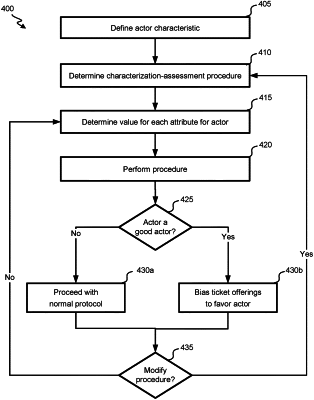| CPC G06Q 10/02 (2013.01) [G06Q 30/02 (2013.01); H04L 63/1483 (2013.01)] | 21 Claims |

|
1. A method for detecting association of a plurality of user devices for allocation of tickets to an event, the method comprising:
repeatedly collecting attribute data associated with the plurality of user devices, the attribute data representing one or more attributes of a first user device of the plurality of user devices, each attribute of the one or more attributes associated with the first user device of the plurality of user devices being collected during an interaction between the first user device and a ticketing system;
detecting association of at least one user device with the first user device to form a group of user devices, wherein the association of the at least one user device with the first user device is detected based on at least one of:
characteristic(s) relating to the event for which the tickets are to be allocated,
comparison of profile of the at least one user device and the first user device,
a geographical location of the at least one user device and the first user device,
a hold request for the tickets from the at least one user device and the first user device,
a reserve request for the tickets from the at least one user device and the first user device,
characteristic(s) of the tickets requested by the at least one user device and the first user device, or
a willingness from each user device in the group of user devices to be a part of the group;
receiving a request for a ticket from each of the user device in the group of user devices, wherein the requests are arranged in a queue; and
modifying position of the requests for each of the user device in the group of user devices in the queue, by executing learning model techniques on the collected attribute data, such that each user device in the group of user devices are placed adjacent to each other in the queue, wherein executing the one or more machine-learning techniques comprises:
calculating a characterization score for each of the user device in the group of user devices based on the collected attribute data,
comparing the calculated characterization score with a threshold value to identify robot users, and
modifying positions of each of the user device in the group of user devices to reprioritize robot users in the queue to move relative to human users based on a determination that the characterization score is below the threshold value.
|